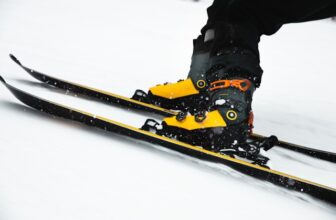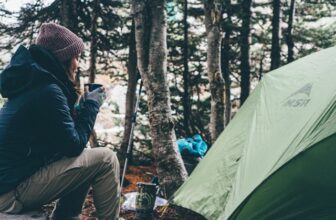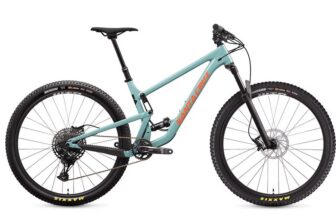Introduction to Skiing as a Sport, Recreation, and Lifestyle
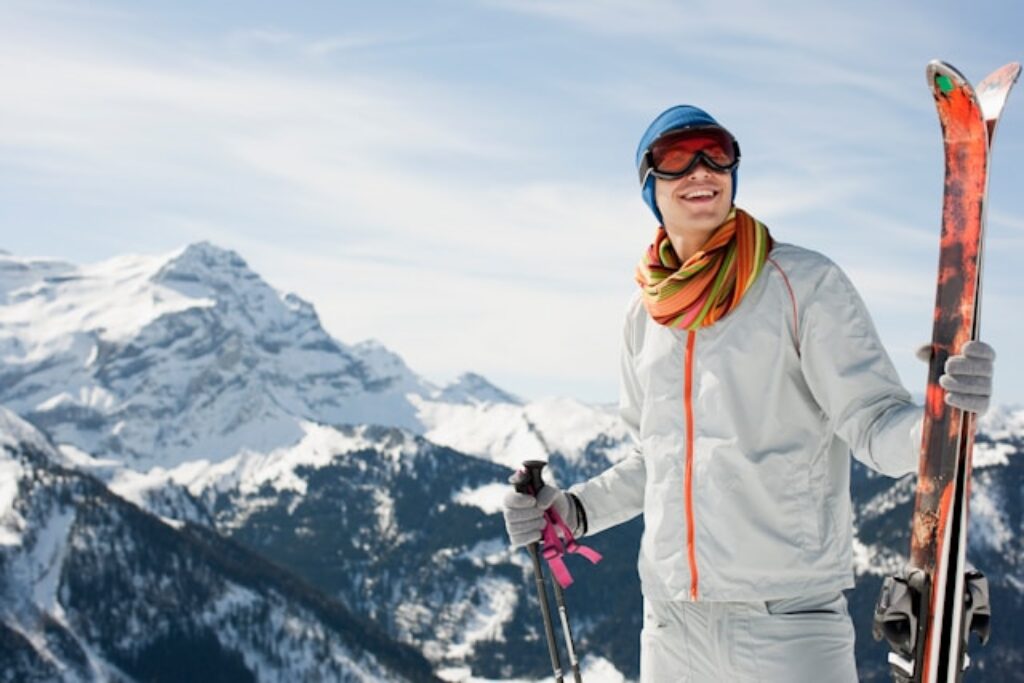
Skiing is more than just a winter activity; it’s a unique blend of sport, recreation, and lifestyle that captures the imagination of millions around the world. As a sport, skiing offers a thrilling challenge that combines physical endurance, balance, and precision, whether you’re racing down a steep mountain or gliding across snowy plains. Its recreational side provides a way to enjoy nature, explore scenic landscapes, and engage in outdoor exercise, all while fostering camaraderie with fellow skiers.
For many, skiing becomes a lifestyle, shaping vacations, fitness routines, and social interactions. From weekend trips to local resorts to international ski holidays, the ski community thrives on shared experiences and the joy of gliding through fresh powder. Whether you’re a casual participant or a competitive athlete, skiing offers a connection to the outdoors, an opportunity to push your limits, and a deeply rewarding experience in both body and mind.
This guide will help you explore skiing in all its forms, equipping you with the knowledge to choose your skiing style, select the right gear, learn the techniques, and make the most of your time on the slopes—whether you’re a first-timer or seasoned pro.
The Popularity of Skiing
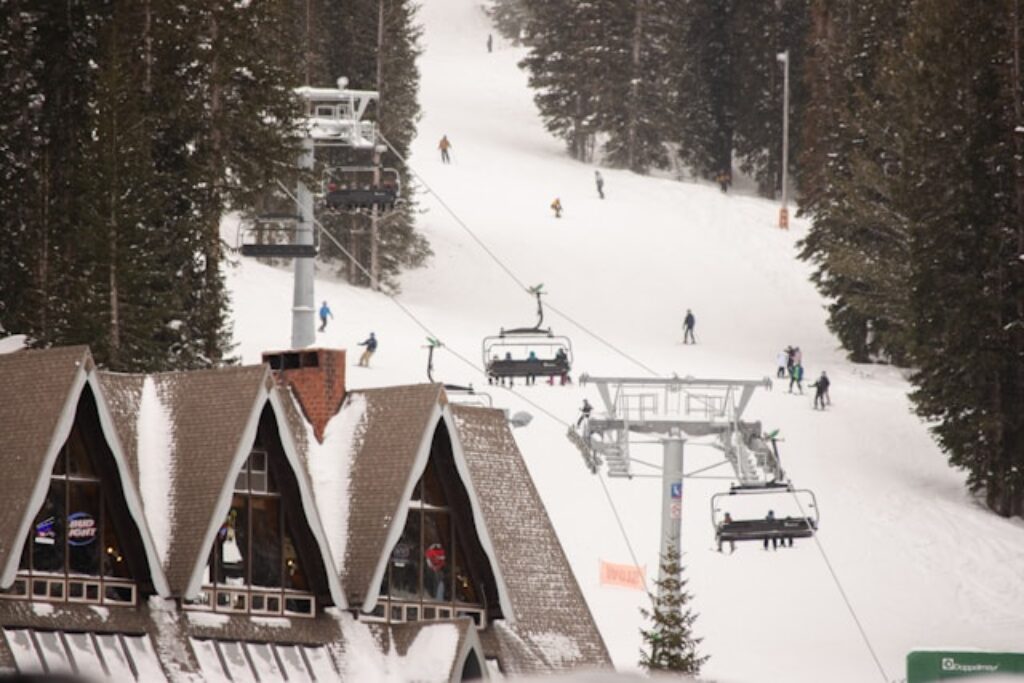
Skiing’s popularity can be attributed to its unique combination of fitness benefits, mental refreshment, and connection with nature, making it a well-rounded activity that appeals to people of all ages and skill levels. From a fitness perspective, skiing offers a full-body workout that engages core muscles, legs, and arms, improving strength, balance, and flexibility. The constant movement required to navigate slopes or cross snowy terrain provides excellent cardiovascular exercise, while the resistance offered by the snow challenges muscles in a way few other sports can. Whether downhill or cross-country, skiing burns calories, boosts stamina, and helps improve overall physical health, making it a go-to activity for those looking to stay fit during the winter months.
Beyond its physical benefits, skiing provides a profound sense of mental refreshment and stress relief. The combination of fresh mountain air, wide-open landscapes, and the rhythmic movement of skiing helps to clear the mind, reduce anxiety, and promote mental clarity. Many skiers describe the experience as meditative, as the focus on technique and navigating trails allows them to escape daily worries. Additionally, skiing fosters a strong connection with nature, offering skiers the chance to immerse themselves in stunning alpine environments or quiet, snow-covered forests. The solitude and beauty of these settings provide a sense of peace and rejuvenation, making skiing not just a physical exercise but a holistic experience that nourishes both body and mind.
Choosing the Right Type of Skiing For You
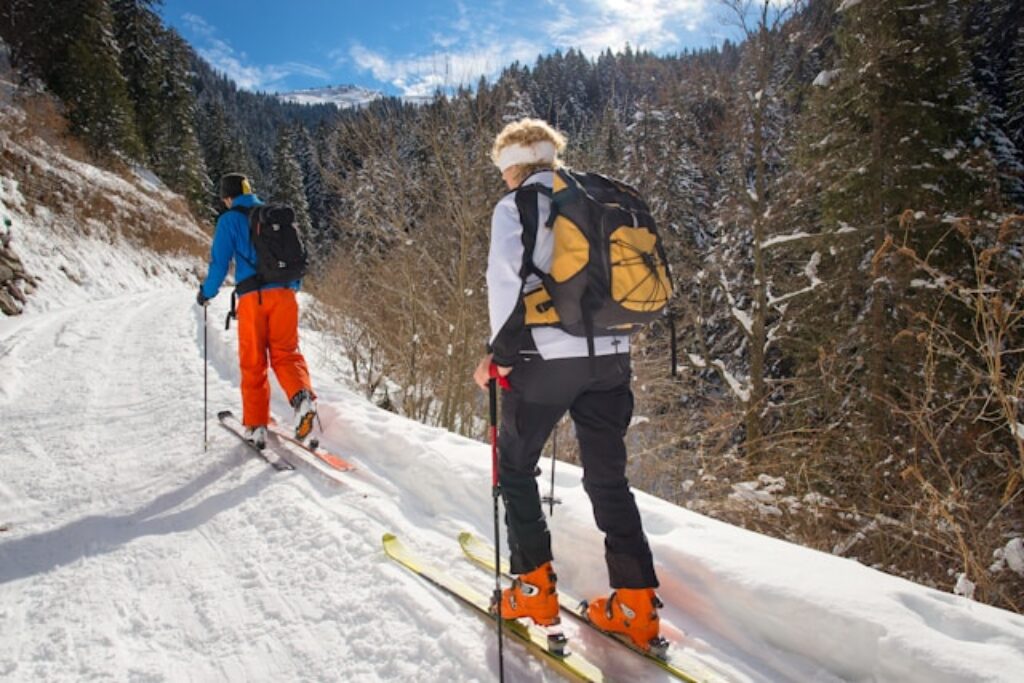
Skiing offers a broad spectrum of styles, each designed for different terrain, skill levels, and interests. Whether you’re seeking the adrenaline rush of high-speed descents, the peaceful rhythm of gliding through snowy forests, or the challenge of conquering backcountry slopes, there is a form of skiing that’s right for you. Choosing the right type of skiing is key to maximizing your enjoyment and safety on the slopes. To make an informed choice, it’s important to understand the various types of skiing and what each offers in terms of experience, physical demands, and required gear.
Factors to Consider When Choosing a Skiing Style:
Terrain Preference
- Do you prefer the groomed slopes of a ski resort, untouched powder in the backcountry, or flatter, snow-covered trails through the wilderness?
Physical Fitness Level
- Consider your fitness level. Some types of skiing, like cross-country or ski mountaineering, require significant endurance, while alpine skiing and freestyle skiing are more about short bursts of power and control.
Skill Level
- If you’re a beginner, alpine or cross-country skiing may be a better starting point due to their accessibility. Advanced skiers might enjoy backcountry skiing or telemark for a greater challenge.
Adventure vs. Technique
- Are you more interested in pushing your technical skills with precise movements or seeking adventure by exploring off-piste terrain?
Social vs. Solo Experience
- Alpine and freestyle skiing are often social, resort-based activities, whereas cross-country and backcountry skiing can offer more solitary, immersive experiences in nature.
Once you’ve assessed your goals, let’s explore the main types of skiing to find out which suits your needs best.
Overview of the Different Types of Skiing
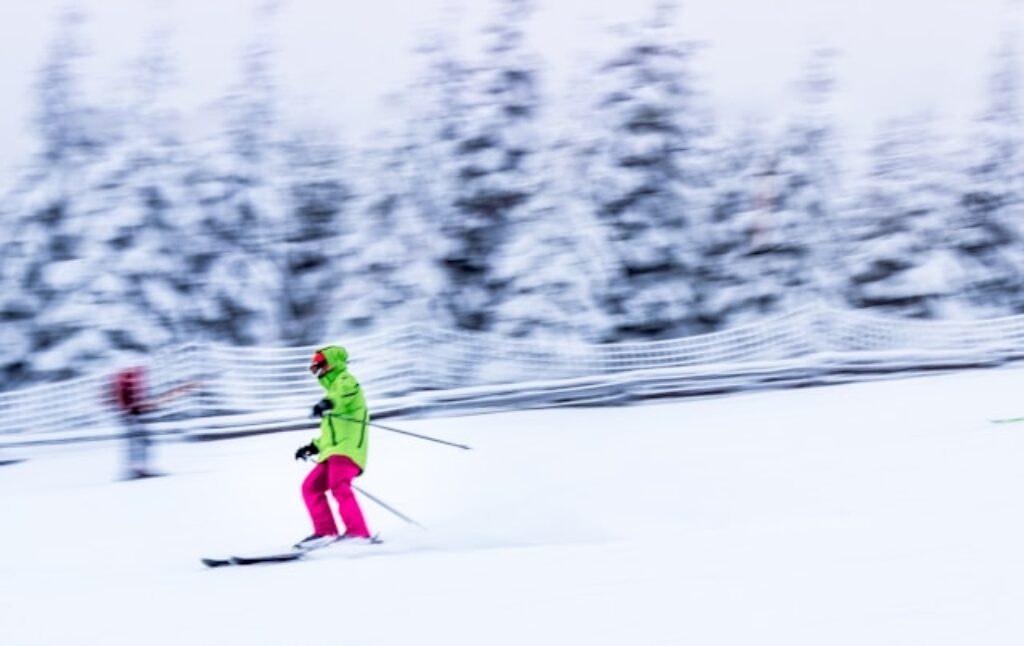
1. Alpine (Downhill) Skiing
Alpine skiing, often referred to as downhill skiing, is the most recognized and widely practiced form of the sport. It involves descending snow-covered slopes using fixed-heel bindings, where your boots are securely locked into the skis. Typically done at ski resorts, alpine skiing offers access to a range of groomed trails designed for different skill levels, from beginner-friendly greens to expert-only black diamond runs. This style is all about speed, control, and the thrill of navigating down a mountain.
Who It’s For:
Alpine skiing is perfect for those who love the exhilaration of high-speed descents and the challenge of maneuvering around obstacles and turns. It’s great for individuals and families, as ski resorts offer lessons for beginners, intermediate slopes for progression, and challenging runs for advanced skiers.
Why Choose Alpine Skiing?
- A wide variety of slopes to suit all skill levels.
- Plenty of resorts with amenities, lessons, and rental options.
- Great for those seeking a blend of social experience and excitement.
2. Cross-Country (Nordic) Skiing
Cross-country skiing, also known as Nordic skiing, is a much different experience from alpine skiing. Instead of speeding down a mountain, cross-country skiers travel across relatively flat or gently rolling terrain using their own power. The heel of the boot remains free to allow for the gliding stride necessary for this type of skiing, which is ideal for long-distance travel through snow-covered landscapes. Cross-country skis are typically narrower and longer than downhill skis to accommodate forward motion over flat terrain.
Who It’s For:
If you enjoy endurance activities, scenic outdoor treks, or prefer a slower, more meditative pace, cross-country skiing may be the best fit. It’s also great for fitness enthusiasts, as it provides a full-body workout that burns a significant number of calories.
Why Choose Cross-Country Skiing?
- A low-impact, cardiovascular workout that’s easy on the joints.
- Ideal for those who prefer exploring nature at a slower pace.
- Less about the thrill of speed, more about the beauty of endurance and outdoor adventure.
3. Freestyle Skiing
Freestyle skiing is for those who enjoy performing tricks, jumps, and aerial maneuvers. This type of skiing often takes place in terrain parks specially designed with jumps, halfpipes, rails, and other features that allow skiers to perform acrobatic moves. The focus here is not on reaching high speeds or covering large distances, but on showcasing creativity and style through tricks and stunts. Within freestyle skiing, there are multiple disciplines, including slopestyle (navigating rails and jumps), halfpipe skiing, and big air (performing tricks off large jumps).
Who It’s For:
Freestyle skiing is perfect for adventurous, creative skiers who enjoy experimenting with their movements and performing tricks. It appeals to younger skiers and those who love the thrill of learning and mastering new skills.
Why Choose Freestyle Skiing?
- A fun, creative way to push boundaries and express yourself on the slopes.
- Terrain parks are common in most ski resorts, making it easy to practice.
- Great for skiers who enjoy the social aspect of skiing and competition.
4. Backcountry Skiing
Backcountry skiing, sometimes referred to as off-piste skiing, is for the true adventurer. Unlike the controlled environment of a ski resort, backcountry skiing takes place in unpatrolled, ungroomed, and often remote areas of mountainous terrain. Skiers typically hike or “skin” (use skis equipped with climbing skins) uphill before skiing down untouched snow. This style requires more preparation and safety awareness due to the inherent dangers of avalanches, unpredictable weather, and challenging terrain.
Who It’s For:
Backcountry skiing is for experienced, highly skilled skiers who are comfortable with all types of terrain and conditions. It’s a fantastic choice for those who seek solitude, adventure, and the satisfaction of skiing in natural, unspoiled environments.
Why Choose Backcountry Skiing?
- Allows you to explore pristine, untouched landscapes far from crowded resorts.
- An exciting challenge for those looking to test their skills in unpredictable environments.
- Requires a deep connection with nature and a sense of adventure.
5. Ski Touring
Ski touring is similar to backcountry skiing but emphasizes the ability to travel uphill efficiently without the need for ski lifts. Special touring gear, such as bindings that allow free-heel movement and climbing skins attached to the bottom of the skis, makes it possible to hike uphill before skiing down. Ski touring can be done in remote backcountry areas or within the boundaries of ski resorts, and it combines the endurance aspect of hiking with the excitement of skiing down a mountain.
Who It’s For:
This type of skiing is for those who enjoy both the physical challenge of uphill travel and the exhilaration of skiing down afterward. It’s perfect for outdoor enthusiasts who want to combine skiing with exploration and mountaineering.
Why Choose Ski Touring?
- Offers the freedom to explore remote areas at your own pace.
- A rewarding combination of hiking and skiing.
- Great for fitness and endurance training.
6. Ski Mountaineering
For those looking to push their limits both physically and mentally, ski mountaineering is a combination of skiing and mountain climbing. Ski mountaineers use climbing techniques and equipment, such as ropes, ice axes, and crampons, to ascend steep, icy sections before skiing down. This type of skiing is highly technical and demands not only advanced skiing skills but also proficiency in mountaineering.
Who It’s For:
Ski mountaineering is for highly skilled, adventurous skiers with a passion for both skiing and climbing. It requires a high level of physical fitness and a willingness to face challenging, sometimes dangerous, conditions.
Why Choose Ski Mountaineering?
- Combines the thrill of skiing with the challenge of mountaineering.
- A great choice for those seeking the ultimate outdoor adventure.
- Offers access to remote, high-altitude locations that few ever experience.
7. Telemark Skiing
Telemark skiing is distinguished by its free-heel binding system, which allows the skier’s heel to lift during turns, creating a distinct lunging motion. The technique combines elements of both alpine and cross-country skiing and can be practiced on or off groomed trails. The lunging movement required for turns makes telemark skiing physically demanding, as it engages both the legs and core.
Who It’s For:
Telemark skiing is for those who appreciate the artistry and tradition of skiing. It’s ideal for skiers who enjoy a physical challenge and are looking for a unique, graceful skiing style.
Why Choose Telemark Skiing?
- Offers a beautiful, fluid skiing style that blends alpine and cross-country techniques.
- Physically demanding, providing a great workout for those who enjoy a challenge.
- Appeals to traditionalists and those looking to connect with the roots of skiing.
8. Freeride Skiing
Freeride skiing combines the freedom of backcountry skiing with the creativity of freestyle. Freeriders seek out natural terrain features—such as cliffs, chutes, and powder fields—to explore while skiing. Unlike freestyle skiing, freeride doesn’t focus on man-made features like terrain parks; instead, it’s about navigating and improvising through natural obstacles and unmarked terrain.
Who It’s For:
Freeride skiing is for adventurous skiers who love the unpredictability and rawness of natural environments. It’s a good fit for those who enjoy both the technical challenge of off-piste skiing and the creativity of freestyle techniques.
Why Choose Freeride Skiing?
- Perfect for skiers who crave freedom and exploration.
- Combines the technical challenge of off-piste skiing with freestyle elements.
- Allows skiers to experience untouched, natural terrain.
9. Adaptive Skiing
Adaptive skiing is designed to make skiing accessible to individuals with disabilities. Using specialized equipment—such as sit-skis, outriggers, and tethers—adaptive skiing allows individuals with physical, cognitive, or sensory disabilities to experience the joy of skiing. Many ski resorts offer adaptive skiing programs with trained instructors to ensure a safe, fun experience for all participants.
Who It’s For:
Adaptive skiing is for individuals with disabilities who want to enjoy skiing in a safe, supportive environment. It’s also for those looking to introduce skiing to friends or family members with disabilities.
Why Choose Adaptive Skiing?
- Makes skiing accessible to everyone, regardless of physical limitations.
- Specialized equipment ensures safety and comfort.
- Fosters inclusion and allows individuals to enjoy the outdoors and ski culture.
Selecting The Appropriate Ski Gear
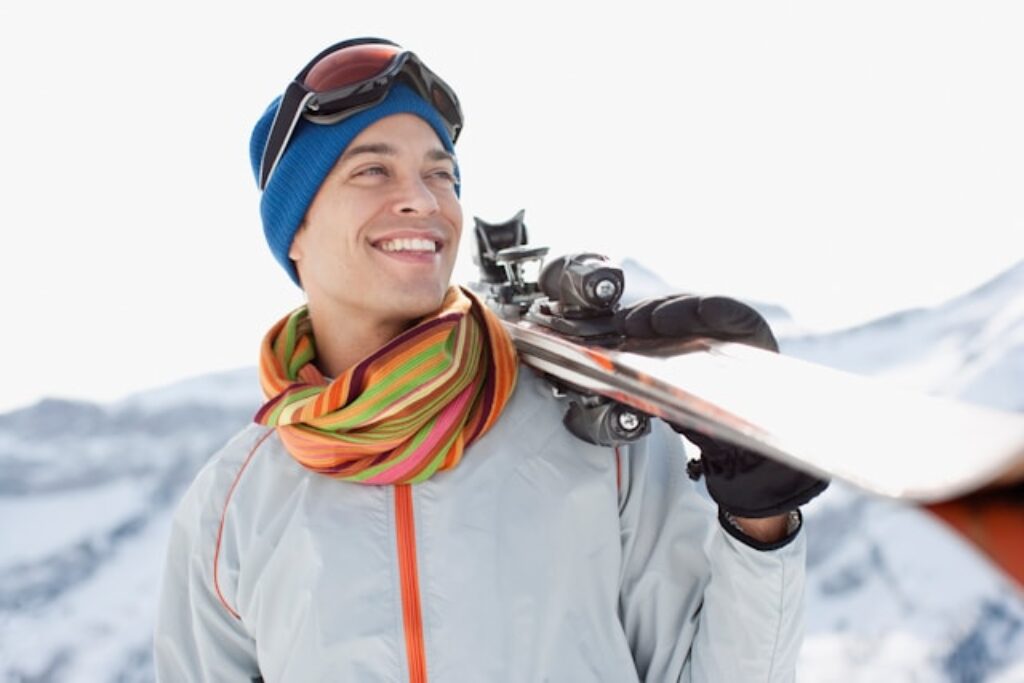
Choosing the right ski gear is essential for both safety and performance on the slopes. Whether you’re a beginner or an experienced skier, having well-fitted, high-quality equipment can significantly enhance your skiing experience. This section covers everything you need to know about selecting skis, boots, bindings, poles, clothing, and accessories. We’ll also include recommendations for some top products to help you get started.
1. Skis
When choosing skis, it’s important to consider your skiing style, ability level, and the type of terrain you’ll be skiing on. Skis come in various shapes and sizes, designed to optimize performance for different conditions.
Types of Skis:
- All-Mountain Skis: Versatile and designed to handle a wide variety of terrain. These are ideal for beginners and intermediates who want one ski for everything.
- Powder Skis: Designed for deep snow, these skis are wider to help you float on powder. Best for advanced skiers who venture off-piste.
- Park and Freestyle Skis: Lighter and shorter, with twin tips (curved at both ends) to help with tricks and jumps in terrain parks. Great for freestyle enthusiasts.
- Carving Skis: Made for precision on groomed trails, these skis have narrow waists and a deep sidecut, allowing for quick, sharp turns. Ideal for advanced skiers who love speed and precision.
- Touring Skis: Lightweight and designed for uphill and backcountry skiing. Often used with special bindings and climbing skins.
Ski Length: Generally, the length of your skis should be between your chin and the top of your head, depending on your ability level and the type of skiing. Beginners may prefer shorter skis for more control, while advanced skiers may choose longer skis for more stability at high speeds.
Specific Products:
- Rossignol Super Black Ops 98 Skis (All-Mountain): A versatile ski that offers stability and control for all types of terrain, great for intermediate to advanced skiers.
- Salomon QST 106 (Powder): Known for its performance in deep snow and variable conditions, this is a favorite among powder skiers.
- K2 Poacher (Park/Freestyle): A popular choice among freestyle skiers, this ski performs well on jumps, rails, and groomed runs.
- Volkl Deacon 80 (Carving): Perfect for skiers who enjoy fast, precise carving on groomed runs.
- Dynafit Seven Summits+ Alpine Touring Ski Set (Touring): A one-and-done lightweight ski touring system that eliminates much of the hassle of selecting and mounting with well-chosen components.
2. Bindings
Bindings are crucial for both safety and performance, as they secure your ski boots to your skis and release in case of a fall to prevent injury. The right bindings depend on your skill level, weight, and the type of skiing you plan to do.
Types of Bindings:
- Alpine Bindings: Standard bindings for downhill skiing, offering strong retention and reliable release when needed.
- Touring Bindings: These allow the heel to lift for uphill travel, and can be locked down for downhill skiing.
- Freestyle Bindings: Designed for park and trick skiing, offering more flexibility and durability.
DIN Setting: The DIN setting on bindings controls how easily the bindings will release in the event of a fall. Your DIN setting should be adjusted based on your weight, height, skiing ability, and the terrain you’ll be skiing on. Beginners typically have lower DIN settings to ensure easy release.
Specific Products:
- Look Pivot 14 GW: A durable alpine binding with a great range of adjustability, suitable for all-mountain skiing.
- Marker Griffon 13 ID: A versatile binding that works for both all-mountain and freestyle skiers.
- Salomon S/Lab Shift MNC: A hybrid binding that performs well for both touring and downhill skiing.
- Tyrolia Attack 13 GW: Ideal for park skiers, offering strong retention with a lightweight design.
3. Ski Boots
Boots are arguably the most important part of your ski setup. The right pair should be snug, comfortable, and supportive. Boots come with varying levels of flexibility (known as the flex rating), which affects how they perform on the slopes.
Fit: Ski boots should feel tight, but not painfully so. The most common issue skiers face is boots that are too large, which can lead to poor control and discomfort. Make sure to get professionally fitted if possible, and consider custom insoles for added comfort.
Flex Rating: Flex measures how stiff the boot is:
- Soft (50-70 flex): Suitable for beginners who need comfort and easy maneuverability.
- Medium (80-100 flex): Best for intermediate skiers, offering a balance of support and flexibility.
- Stiff (110+ flex): Designed for advanced and expert skiers who require maximum control and responsiveness at high speeds.
Specific Products:
- Tecnica Mach1 120: A high-performance boot with a medium-stiff flex, perfect for intermediate to advanced skiers.
- Salomon X Pro 100: A versatile boot with customizable features, ideal for all-mountain skiers.
- Dalbello Panterra 90 GW: A softer flex boot, great for intermediate skiers who prioritize comfort.
- Atomic Hawx Ultra 130: For expert skiers who demand high responsiveness and control in all conditions.
4. Poles
Ski poles help with balance and timing on the slopes. Choosing the right pair involves considering your height, skiing style, and terrain.
Length: To find the right length, flip the pole upside down and grab it just under the basket. Your arm should be at a 90-degree angle when holding the pole.
Material:
- Aluminum Poles: Lightweight and durable, ideal for all-mountain skiing.
- Carbon Fiber Poles: Lighter and stiffer than aluminum, these are better for advanced skiers and those skiing on groomed runs.
- Adjustable Poles: Perfect for backcountry skiing, allowing you to adjust the length depending on whether you’re skiing uphill or downhill.
Specific Products:
- Leki Carbon 14 S Ski Poles: These poles are a good fit for skiers looking to tackle different types of terrain without compromising on performance or comfort.
- Black Diamond Traverse: An adjustable backcountry pole, perfect for touring and backcountry adventures.
- Rossignol Tactic Carbon: A lightweight, carbon-fiber option for skiers who prioritize performance and speed.
5. Clothing
Staying warm and dry is critical when skiing, and dressing in layers is the best approach. The right clothing ensures you stay comfortable regardless of changing weather conditions.
- Base Layers: The first layer should wick moisture away from your body. Look for moisture-wicking, breathable fabrics like merino wool or synthetic materials.
- Specific Products:
- Smartwool Merino 250: A highly recommended base layer for warmth and moisture control.
- Patagonia Capilene Midweight: Another excellent choice for staying dry and warm.
- Specific Products:
- Mid Layers: The second layer provides insulation. Fleece, down, or synthetic jackets work well.
- Specific Products:
- The North Face ThermoBall Jacket: Lightweight, packable, and warm.
- Arc’teryx Atom LT: A versatile, synthetic mid-layer that is great for cold-weather skiing.
- Specific Products:
- Outer Layers: Your outermost layer should be waterproof and windproof to protect against the elements.
- Ski Jackets: Look for jackets with waterproofing (measured in millimeters), breathability, and insulation.
- Specific Products:
- Helly Hansen Alpha 3.0: A premium ski jacket offering excellent waterproofing and insulation.
- Columbia Whirlibird IV Interchange: A budget-friendly option with a 3-in-1 design.
- Specific Products:
- Ski Pants: Should be waterproof, durable, and provide freedom of movement.
- Specific Products:
- Arc’teryx Sabre AR Pants: Top-of-the-line waterproof pants, great for all conditions.
- Burton AK Gore-Tex 2L Pants: High-performance and highly durable, perfect for demanding skiers.
- Specific Products:
- Ski Jackets: Look for jackets with waterproofing (measured in millimeters), breathability, and insulation.
6. Helmet and Goggles
Wearing a helmet is a crucial safety measure for skiers of all levels. Goggles help with visibility in varying light and snow conditions.
- Helmets: Look for helmets with adjustable fit systems, ventilation, and MIPS technology for enhanced protection.
- Specific Products:
- Smith Vantage MIPS: Known for its comfort, ventilation, and safety features.
- Giro Range MIPS: A top choice for comfort and protection.
- Specific Products:
- Goggles: Good goggles should offer UV protection, anti-fog coatings, and interchangeable lenses for different light conditions.
- Specific Products:
- Oakley Flight Deck: Offers excellent peripheral vision and interchangeable lenses.
- Smith I/O Mag: A popular choice for its ease of lens swapping and wide field of view.
- Specific Products:
7. Accessories
Ski Socks: Invest in high-quality, moisture-wicking ski socks to avoid cold feet and blisters. Merino wool or synthetic blends are the best choices.
Gloves or Mittens: Choose waterproof, insulated gloves or mittens for warmth.
- Specific Products: Hestra Army Leather Heli Ski Gloves, Black Diamond Guide Gloves.
Neck Gaiters and Balaclavas: Great for protecting your face from wind and cold. Look for breathable and moisture-wicking materials.
- Specific Products: Buff Original Multifunctional Headwear, Outdoor Research Sonic Balaclava.
Learning to Ski: Getting Started
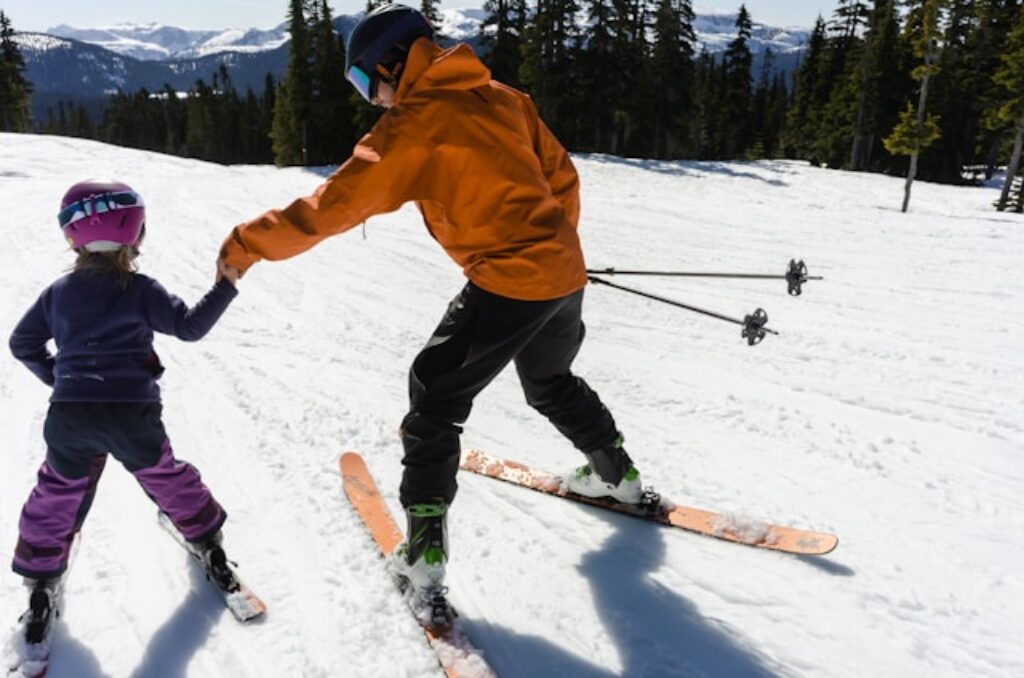
Learning to ski can be an exciting yet challenging experience, especially for beginners. While skiing might look effortless from a distance, it requires a combination of balance, technique, and confidence. The good news is that with the right guidance and preparation, anyone can learn to ski, regardless of age or fitness level. In this section, we’ll guide you through the essential steps to get started, including lessons, understanding ski slopes, mastering basic techniques, and developing body positioning.
1. Starting with Ski Lessons
For those new to skiing, starting with professional lessons is highly recommended. While it may be tempting to learn from friends or try to teach yourself, a qualified instructor can provide structured guidance, ensuring you develop proper form and technique right from the beginning. Ski lessons also help build confidence and reduce the risk of injury by teaching you essential safety skills.
Group Lessons vs. Private Lessons
- Group Lessons: Typically more affordable, group lessons are a great way to meet other beginner skiers and learn in a supportive, social environment. Instructors divide groups based on skill level, so you’ll be surrounded by people learning at the same pace as you.
- Private Lessons: While more expensive, private lessons offer personalized instruction, allowing the teacher to focus solely on you and cater to your specific needs. If you want to progress quickly or feel more comfortable with one-on-one attention, private lessons are an excellent choice.
Lesson Duration and Frequency
Most ski schools offer lessons that last between 1 to 3 hours. For beginners, shorter, frequent lessons (over several days) are often more effective than long, intensive sessions. Skiing requires muscle memory, and taking breaks allows your body to rest and process what you’ve learned.Learning in a Controlled Environment
Most ski resorts have designated beginner areas known as bunny slopes or nursery slopes. These are gentle, shallow slopes with slow-moving ski lifts, allowing new skiers to practice without the pressure of steeper, more advanced terrain. Many of these areas also have magic carpets—slow-moving conveyor belts that transport beginners to the top of the hill—making it easier to get comfortable on the slopes without worrying about handling ski lifts.
2. Understanding the Ski Slopes
When learning to ski, it’s important to familiarize yourself with the various types of ski slopes and trails. Each ski resort uses a standardized system to rate the difficulty of their slopes, so you know which ones are appropriate for your skill level.
Trail Ratings
Ski trails are categorized by color-coded symbols, which indicate their level of difficulty. It’s essential to respect these ratings and stick to trails that match your skill level as a beginner.- Green Circles: Beginner slopes that are wide, gently sloped, and not too fast. These are ideal for your first days on the mountain.
- Blue Squares: Intermediate trails that feature steeper pitches and tighter turns. As you gain confidence, you can begin to tackle blue runs.
- Black Diamonds: Advanced and expert trails with steep drops, moguls, and challenging terrain. These are for experienced skiers only.
- Double Black Diamonds: Reserved for experts, these trails are often very steep, with cliffs, obstacles, or off-piste sections.
Mountain Signage and Maps
Familiarize yourself with the resort’s trail map and signage before venturing out. Ski trails are well-marked with signs and colored symbols, making it easy to navigate the mountain. Always follow the signs and stay on marked trails, especially when you’re just starting.
3. Mastering Basic Ski Techniques
Before progressing to more advanced skills, it’s crucial to build a solid foundation with the basic skiing techniques. These will help you control your speed, navigate turns, and maintain balance on the slopes.
The Pizza (Snowplow)
The snowplow—often referred to as the “pizza” stance by instructors—is the first technique most beginners learn. In this stance, you form an inverted “V” with the tips of your skis pointing toward each other, while the tails are kept apart. This position helps you control your speed by creating friction with the snow and is essential for slowing down and stopping on gentle slopes.- How to Practice the Snowplow: Stand with your skis parallel and gradually push the tails of your skis outwards while keeping the tips close together. Practice gliding down gentle slopes in this position and stopping by widening your snowplow.
Sidestepping and Using Ski Lifts
Learning how to sidestep uphill is an important skill for navigating short distances on the slope without having to take off your skis. To sidestep, keep your skis perpendicular to the slope, plant your poles for balance, and step sideways up the hill with small, deliberate movements.
Using a ski lift for the first time can feel intimidating, but it’s easier than it looks. Beginners typically use chair lifts or magic carpets. When using a chair lift, sit back once the chair arrives, keep your poles tucked in, and stand up when you reach the top, gliding away smoothly.Turning
Once you’ve mastered the snowplow and can control your speed, the next step is learning to turn. Wedge turns are the first type of turn you’ll learn. To initiate a wedge turn, apply pressure on one ski (typically by pushing your big toe into the inside edge of your boot), causing your skis to point in the direction you want to go. Alternate applying pressure on each ski to make smooth, gradual turns as you descend the slope.
As you become more confident with wedge turns, you can start transitioning into parallel turns, where your skis remain parallel throughout the turn, offering more control and fluidity on the slopes.
4. Balancing and Body Positioning
Maintaining proper balance and posture is key to progressing in skiing. Being in control of your body’s positioning helps you remain stable and maneuver efficiently as you navigate different slopes and terrain.
Staying Centered Over Your Skis
A common mistake beginners make is leaning too far back. This “back seat” position puts more weight on the tails of your skis, making it harder to control turns and speed. Instead, focus on staying centered over your skis by keeping your weight evenly distributed between your heels and toes. Imagine your body forming a straight line from your head to your feet, with a slight forward lean.Hands Forward and Knees Bent
Keeping your hands forward is an important aspect of proper skiing form. Imagine you’re holding two trays in front of you—this helps keep your balance centered and prevents you from leaning backward. Additionally, maintaining a slight bend in your knees gives you more control and flexibility to absorb bumps and adjust to changes in the terrain.Shifting Your Weight
Learning to shift your weight from one ski to the other is essential for mastering turns and controlling your direction. As you initiate a turn, shift your weight to the ski that’s on the outside of the turn (the downhill ski), while lightening the pressure on the inside ski. Practice this weight transfer until it becomes second nature.
5. Building Confidence and Progressing
Skiing can be physically demanding and sometimes intimidating for beginners, but with patience and practice, you’ll start to feel more comfortable and confident on the slopes. Here are a few tips for building confidence as you learn:
Start Small and Gradually Increase Difficulty
Don’t rush the process—start with the easiest slopes and move up to more challenging terrain only when you feel confident. It’s important to master the basics before tackling steeper slopes or trying advanced techniques.Practice Consistently
Like any skill, skiing requires repetition to improve. Try to ski multiple days in a row, even if for short periods. This consistency helps develop muscle memory and makes progress feel more natural.Take Breaks and Rest
Skiing is physically demanding, especially for beginners who are using muscles they may not be accustomed to. Take regular breaks to rest your legs and prevent fatigue. Staying hydrated and nourished is also important for maintaining energy on the slopes.
6. Overcoming Common Beginner Challenges
It’s natural to face challenges when you’re learning to ski, but being aware of these difficulties and knowing how to address them can speed up your progress:
Fear of Falling: One of the most common fears among new skiers is falling. While it’s impossible to avoid falling completely, learning how to fall safely (keeping your hands in front of you and avoiding sharp objects) can reduce injuries and boost your confidence.
Struggling with Control: Beginners often feel out of control when they first start skiing. Focus on mastering the snowplow and wedge turns, as these techniques will help you control your speed and direction.
Difficulty with Ski Lifts: Getting on and off the ski lift can be tricky at first, but it gets easier with practice. If you’re nervous, let the lift operator know, and they can slow it down for you.
Intermediate to Advanced Ski Techniques
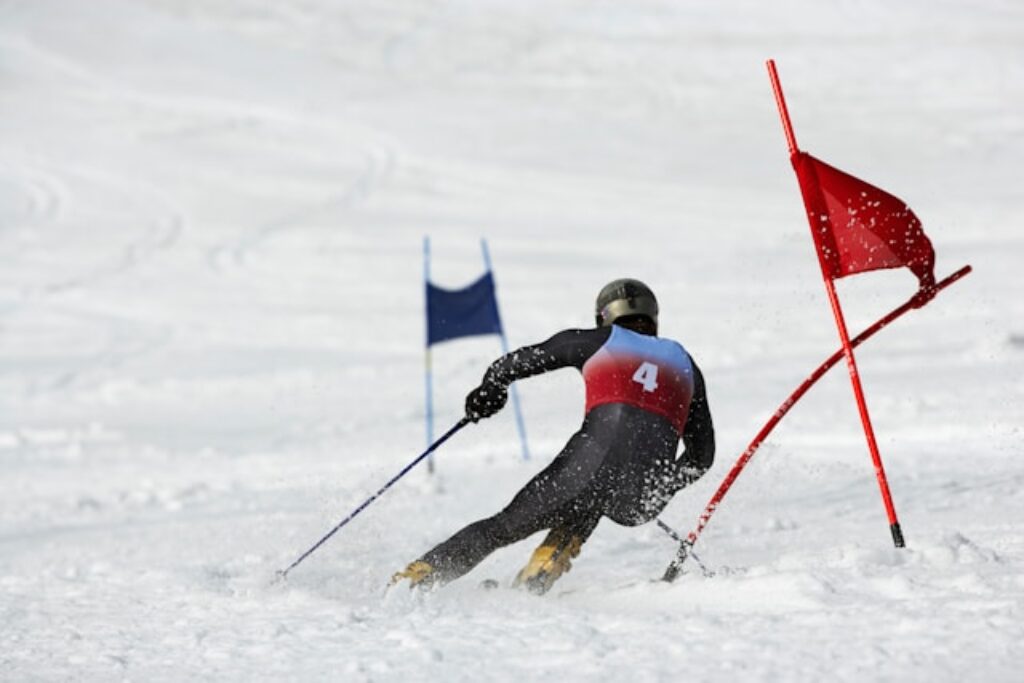
Once you’ve mastered the basics of skiing—such as controlling your speed, making wedge turns, and maintaining balance—it’s time to move on to more advanced techniques. Developing these skills will allow you to ski more challenging terrain with greater control, precision, and confidence. In this section, we’ll dive into intermediate and advanced skiing techniques, including carving, parallel turns, short turns, mogul skiing, off-piste techniques, freestyle tricks, and skiing in powder. These skills are essential for skiers looking to elevate their game and explore a wider range of mountain experiences.
1. Carving
Carving is a technique that involves using the edges of your skis to make clean, arced turns on groomed trails, allowing for greater speed and control. Unlike basic wedge turns, where you skid through the snow, carving lets your skis slice into the snow, creating a smooth, effortless glide.
How to Initiate a Carve
Carving begins by shifting your weight onto the edges of your skis. To initiate a turn, lean into the turn by pressing down on the inside edge of your outside ski while tilting your inside ski’s edge into the snow. Your skis will naturally follow the arc as they carve through the snow, leaving a clean line behind.Key Focus Points:
- Edge Control: The key to carving is keeping your skis on edge throughout the turn. Avoid flattening your skis mid-turn, as this will cause you to skid.
- Pressure Distribution: Most of your weight should be on the outside ski during the turn. This helps create a deeper carve and gives you more control.
- Body Positioning: Stay low by bending your knees and keep your upper body facing downhill. Your shoulders should remain square to the slope while your legs rotate underneath you.
Tips for Mastering Carving:
- Start with shallow carves on groomed slopes to get a feel for the technique before progressing to steeper terrain.
- Focus on using your hips and knees to tip the skis onto their edges rather than relying solely on your feet.
- Practice keeping both skis parallel throughout the turn for smoother, faster carves.
2. Parallel Turns
Parallel turns are a key progression from wedge turns and are crucial for intermediate skiers looking to refine their technique. In parallel turns, both skis remain parallel throughout the turn, providing more control, fluidity, and speed. This technique is especially useful on steeper slopes where wedge turns can be limiting.
How to Transition to Parallel Turns
As you progress from wedge turns, begin to bring your skis closer together while initiating the turn. Once you’re confident in controlling your speed and direction, keep your skis parallel throughout the entire turn.Steps to Perform a Parallel Turn:
- Start by moving into a shallow traverse (sideways motion) across the slope with your skis parallel.
- Shift your weight onto your downhill ski, allowing your skis to edge into the snow.
- Initiate the turn by gently rotating both skis in the direction you want to go while keeping them parallel.
- As you complete the turn, transfer your weight to the opposite ski, ready for the next turn.
Tips for Perfecting Parallel Turns:
- Keep your knees slightly bent and your body balanced over your skis.
- Focus on smooth weight transfers from one ski to the other to ensure fluid turns.
- Practice linking your turns seamlessly without pausing between them.
3. Short Turns
Short turns are quick, controlled turns that are useful for navigating narrow or steep trails, crowded slopes, or challenging terrain like moguls. Unlike longer, sweeping turns, short turns are made in rapid succession, allowing you to maintain control while skiing down steep or tight areas.
Technique for Short Turns:
- Start with your skis parallel and your body facing downhill.
- Use your core and lower body to initiate quick, controlled rotations of the skis.
- Engage the edges of both skis, and focus on turning your feet and legs underneath a stable upper body.
- Keep your turns short and sharp by pivoting your skis rather than relying on large edge angles.
Tips for Mastering Short Turns:
- Maintain a rhythm as you link short turns together.
- Stay centered over your skis to avoid losing control on steeper slopes.
- Practice on gentler terrain before progressing to more challenging areas.
4. Mogul Skiing
Skiing moguls—small, tightly packed snow bumps—requires a combination of quick turns, balance, and the ability to absorb uneven terrain. Moguls add a level of unpredictability, so they demand fast reflexes and efficient turning skills.
Technique for Skiing Moguls:
- Absorption and Extension: As you approach a mogul, absorb the bump by bending your knees and ankles, then extend your legs into the trough between moguls. This helps you maintain contact with the snow and reduces the impact of each bump.
- Short, Controlled Turns: To navigate moguls, use short, quick turns. Keep your upper body steady and focused downhill while your legs make rapid adjustments to each bump.
- Line Choice: You can either ski around the sides of the moguls (the “trough”) or go directly over the tops of them (the “zipper line”). The trough is easier and allows for more controlled turns, while the zipper line is faster and more challenging.
Tips for Skiing Moguls:
- Start by practicing short turns on groomed terrain to get a feel for the quick, controlled movements required in mogul skiing.
- Focus on absorbing the bumps with your legs, not your upper body, to maintain balance and control.
- Choose the right line for your skill level—start with the troughs and progress to the zipper line as you gain confidence.
5. Off-Piste and Backcountry Skiing
Off-piste skiing refers to skiing outside the groomed trails at a ski resort, while backcountry skiing typically involves skiing in unpatrolled, ungroomed areas away from resorts. Both require advanced skills and specialized equipment to handle varying snow conditions, including deep powder, ice, and uneven terrain.
Key Techniques for Off-Piste Skiing:
- Stay Centered: Off-piste conditions can be unpredictable, so it’s important to maintain a balanced stance with your weight evenly distributed between both skis.
- Adjust Your Turns: In powder, you’ll need to make wider, more gradual turns to stay afloat. In icy or uneven terrain, focus on maintaining strong edge control for precise turns.
- Speed Control: Off-piste skiing often involves steeper slopes and unpredictable conditions, so learning to control your speed by making consistent, fluid turns is crucial.
Safety Considerations:
- Always check avalanche forecasts and bring appropriate safety gear, including an avalanche beacon, probe, and shovel, when skiing in the backcountry.
- Never ski off-piste alone—partner up and consider hiring a guide if you’re unfamiliar with the terrain.
- Be aware of changing weather and snow conditions, and know how to identify and avoid avalanche-prone areas.
6. Freestyle Skiing Techniques
Freestyle skiing involves performing tricks, jumps, and spins in terrain parks or on natural features. It’s all about creativity and style, with an emphasis on jumps, grabs, spins, and rail slides. Freestyle skiing can be done in specific areas known as terrain parks, where there are jumps, halfpipes, and rails, or in natural environments.
Jumps and Air Control:
- Start by mastering small jumps and gradually work your way up to larger ones.
- Pop Off the Lip: As you approach the jump, bend your knees and extend your legs as you reach the takeoff point. This “pop” helps you gain control in the air.
- Balance in the Air: Keep your core tight and your body centered to maintain stability while airborne. Extend your arms out for balance if needed.
Grabs and Spins:
- Grabs: Once you’re comfortable with air control, start practicing grabs, where you reach down and grab one of your skis mid-air. Popular grabs include the safety grab (grabbing under your ski) and the mute grab (grabbing across your body).
- Spins: Spins require strong takeoff technique and air awareness. Start with 180-degree spins and progress to 360s and beyond. Focus on turning your head and shoulders in the direction of the spin to initiate the rotation.
Rails and Boxes:
- Approach with Confidence: As you approach a rail or box, keep your knees slightly bent and your eyes focused on the end of the feature.
- Balance and Slide: When sliding across the rail, keep your skis flat and maintain balance by staying centered over the rail. Use your arms for stability and avoid leaning too far forward or backward.
7. Skiing in Powder
Skiing in deep powder is one of the most exhilarating experiences on the mountain, but it requires a different technique than skiing on groomed trails. The soft, deep snow demands more effort and balance to stay afloat and in control.
Key Powder Skiing Techniques:
- Stay Leaned Back: Unlike on groomed slopes, in powder, you’ll need to lean back slightly to prevent the tips of your skis from diving into the snow.
- Use a Wider Stance: A wider stance helps you maintain balance and control while skiing through deep snow. It also helps distribute your weight more evenly across both skis.
- Keep Your Skis Together: In powder, it’s important to keep your skis closer together to allow them to work as a single platform, which helps you float on top of the snow.
- Gentle, Fluid Movements: Powder skiing rewards smooth, gradual turns rather than sharp, quick movements. Allow your skis to gently float through the snow, and avoid making abrupt stops or turns.
Tips for Powder Skiing:
- Use your legs to absorb bumps and changes in the terrain, keeping your upper body relaxed and facing downhill.
- Practice skiing powder on less steep slopes before attempting more advanced powder runs.
- Use poles for added stability and rhythm as you move through deep snow.
Skiing Safety and Precautions
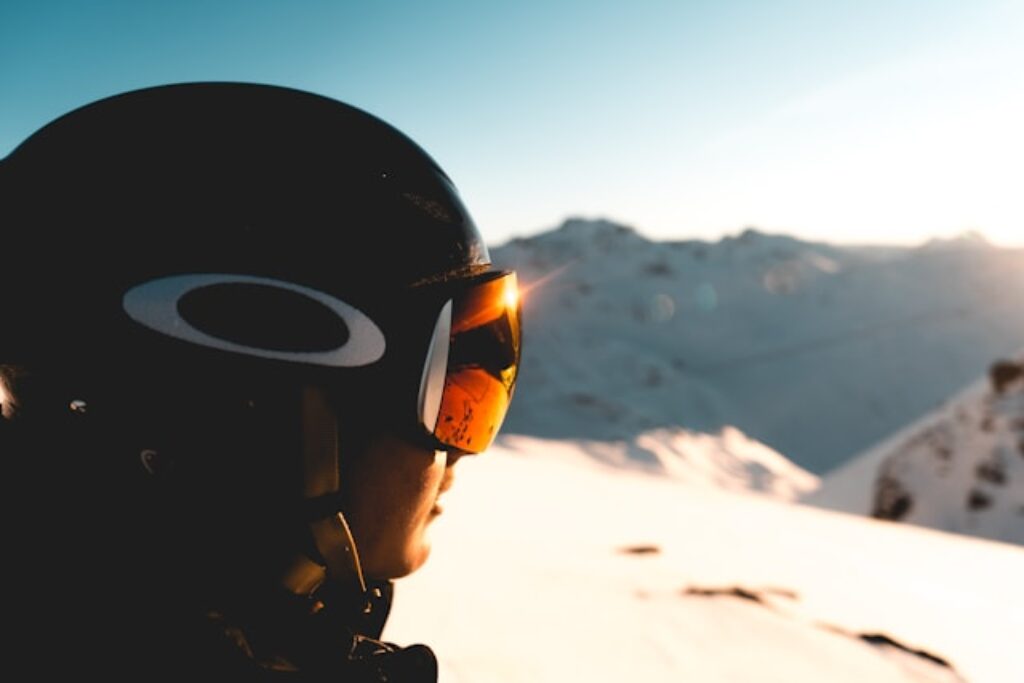
Skiing is an exhilarating sport, but it also comes with inherent risks, especially for those who are unfamiliar with the terrain, weather conditions, or techniques required to navigate the slopes safely. Whether you’re a beginner or an experienced skier, understanding and practicing proper safety protocols is essential to avoid injury and ensure a positive skiing experience. This section covers the critical safety measures every skier should be aware of, including general rules, the importance of wearing a helmet, avalanche safety, weather considerations, and the role of ski patrol.
1. Basic Safety Rules
Regardless of your skill level, adhering to basic safety rules can significantly reduce the risk of accidents and injuries. These guidelines not only help you stay safe but also ensure the well-being of others on the mountain.
Follow the Skier’s Responsibility Code
Many ski resorts adhere to a set of safety rules known as the Skier’s Responsibility Code, which is designed to promote responsible behavior on the slopes. The key points include:- Always stay in control and be able to stop or avoid other people or objects.
- People ahead of you have the right of way. It’s your responsibility to avoid them.
- Don’t stop where you obstruct a trail or are not visible from above.
- When merging onto a trail or starting downhill, look uphill and yield to others.
- Always use devices to prevent runaway equipment.
- Observe all posted signs and warnings. Stay off closed trails and out of closed areas.
- Before using any lift, know how to load, ride, and unload safely.
Control Your Speed
One of the most common causes of skiing accidents is skiing too fast, especially for the conditions or terrain. Make sure to adjust your speed to match your ability level and the terrain you’re skiing. On busy slopes, slow down to avoid collisions with other skiers.Respect Trail Signs and Boundaries
Ski resorts clearly mark trails based on their difficulty (green for beginners, blue for intermediates, and black for advanced skiers). Always choose trails appropriate for your skill level and respect any closed areas or “no entry” zones. These areas may be off-limits due to avalanche danger, poor snow conditions, or other hazards.Use Proper Equipment
Ensuring that your equipment is in good condition and properly fitted is a crucial safety measure. Ill-fitting boots, improperly adjusted bindings, or damaged skis can lead to loss of control and injury. If you’re renting equipment, have it fitted by a professional.
2. Wearing a Helmet
Wearing a helmet is one of the simplest yet most effective ways to protect yourself from head injuries while skiing. Although skiing is a relatively safe sport, accidents can happen, especially in the event of falls or collisions with other skiers, trees, or obstacles. Helmets are widely recommended for all skiers, regardless of skill level.
Benefits of Wearing a Helmet
Helmets provide protection against head injuries, including concussions, which are common in skiing accidents. They also help to keep your head warm and comfortable in cold weather. Modern ski helmets are lightweight, well-ventilated, and designed for maximum safety.Selecting the Right Helmet
When choosing a helmet, make sure it fits snugly and comfortably without being too tight. It should cover your forehead and sit level on your head, with the chinstrap fastened securely. Many helmets come with adjustable fit systems to ensure a proper fit. Look for helmets with MIPS (Multi-directional Impact Protection System), which provides additional protection in the event of rotational impacts.Tips for Using Helmets:
- Replace your helmet after any significant impact, even if it appears undamaged.
- Avoid wearing hats or thick headgear under your helmet, as this can affect its fit and effectiveness. Instead, opt for thin, moisture-wicking layers if you need additional warmth.
3. Avalanche Safety (For Backcountry Skiers)
If you plan to venture into the backcountry or ski off-piste, it’s essential to understand avalanche safety. Avalanches are a serious risk in ungroomed, uncontrolled terrain, and being caught in one can be life-threatening. Proper preparation, training, and equipment are vital for anyone considering backcountry skiing.
Check Avalanche Forecasts
Before heading into the backcountry, always check the local avalanche forecast. Various online resources and apps provide up-to-date information about avalanche risk levels in specific areas. Avoid skiing in areas with high avalanche danger.Essential Avalanche Safety Equipment
Every skier heading into the backcountry should carry the following equipment:- Avalanche Beacon: A transceiver that sends and receives radio signals, allowing rescuers to locate you in the event of an avalanche.
- Probe: A collapsible pole used to probe the snow for buried victims.
- Shovel: Essential for digging out someone buried in an avalanche. Choose a lightweight, sturdy shovel designed for backcountry use.
- Avalanche Airbag Pack: Some skiers also use backpacks with built-in airbags that can be deployed in an avalanche to help them stay on the surface of the snow.
Avalanche Training
Even with the right equipment, it’s crucial to know how to use it effectively. Take an avalanche safety course to learn how to assess snow conditions, recognize avalanche-prone areas, and perform a rescue. Avalanche training will teach you how to use your beacon, probe, and shovel in a real-life scenario.Travel with a Partner
Never ski in the backcountry alone. Always travel with at least one partner and ensure that everyone in the group is equipped with avalanche safety gear. Establish clear communication and agree on safe routes before you begin.
4. Weather Conditions
Weather can change rapidly in mountainous regions, and it’s important to be aware of how changing conditions can impact your safety on the slopes. Whether it’s visibility, wind, snow, or temperature, understanding the weather is key to avoiding dangerous situations.
Monitor Weather Forecasts
Always check the weather forecast before heading to the ski resort or backcountry. Pay attention to temperature changes, wind speeds, and snow conditions. Resorts often update their websites or apps with real-time weather information, including potential closures due to weather.Skiing in Poor Visibility
Fog, heavy snow, and flat light (when overcast skies reduce contrast, making it difficult to see terrain features) can make it hard to navigate. If visibility is poor:- Stick to familiar trails or ski near the trees where visibility is often better.
- Wear goggles with low-light lenses designed to enhance contrast in flat light conditions.
- Slow down and maintain a cautious speed to avoid obstacles or other skiers.
Skiing in Icy Conditions
Ice can make skiing more dangerous, especially for beginners. Icy slopes require excellent edge control and confidence in turning techniques. If the conditions are icy:- Stick to slopes you’re comfortable with, as falling is more likely in these conditions.
- Focus on maintaining strong edge control and avoid skiing at high speeds.
- Consider taking a break or skiing on lower elevations, where the snow might be softer.
Cold Weather and Hypothermia
Cold temperatures combined with wind can lead to hypothermia or frostbite if you’re not properly dressed. Make sure to dress in layers, with a moisture-wicking base layer, insulating mid-layers, and a waterproof outer shell. Also, wear warm gloves, a hat or helmet liner, and a neck gaiter. Take regular breaks indoors to warm up if necessary, and be aware of the signs of hypothermia (shivering, confusion, slurred speech) and frostbite (numbness, tingling, or white patches on exposed skin).
5. Ski Patrol
Ski patrol teams play a crucial role in maintaining safety on the mountain. They are trained to provide first aid, assist in rescues, enforce safety rules, and monitor trail conditions. Knowing how to contact ski patrol and when to seek their help can make a big difference in emergency situations.
What Does Ski Patrol Do?
Ski patrol is responsible for:- Providing first aid and emergency medical care for injured skiers.
- Marking hazardous areas, setting up boundary lines, and closing unsafe trails.
- Conducting searches and rescues in the event of an avalanche or missing skier.
- Enforcing ski resort rules to prevent dangerous behavior.
How to Contact Ski Patrol
Most ski resorts provide easy ways to contact ski patrol in case of emergency:- Dial the ski patrol number provided on your trail map or resort signage.
- Use emergency phones located at the top or bottom of lifts or at major trail intersections.
- Alert any resort staff, lift operator, or nearby skier if you’re unable to call for help yourself.
When to Call Ski Patrol
Call ski patrol immediately if:- Someone is injured and cannot continue skiing.
- You witness an accident and the skier needs assistance.
- You encounter a hazardous condition that needs to be addressed (such as an unmarked cliff, downed tree, or dangerous ice patch).
- You or someone in your group gets lost or is caught in an avalanche.
6. Prevention and Precautionary Measures
Finally, being proactive about your safety can help prevent accidents and injuries before they happen.
Warm Up Before Skiing
Skiing is a physically demanding sport, and it’s essential to warm up your muscles before hitting the slopes. Simple stretches or light exercises can help increase flexibility and reduce the risk of muscle strains or injuries. Focus on warming up your legs, hips, and core muscles, as these are heavily engaged during skiing.Stay Hydrated and Well-Nourished
Skiing at high altitudes can lead to dehydration more quickly than you might expect. Bring a water bottle or hydration pack with you and make sure to drink regularly throughout the day. It’s also important to eat enough calories to keep your energy levels up. Pack snacks like energy bars, nuts, or fruit for quick, healthy refueling.Know Your Limits
One of the most important aspects of skiing safely is recognizing your limitations. Don’t push yourself to ski trails that are beyond your current skill level. Skiing when tired or trying to keep up with more experienced skiers can lead to accidents. Take regular breaks, ski within your ability, and enjoy the experience at your own pace.
Injury Prevention and First Aid
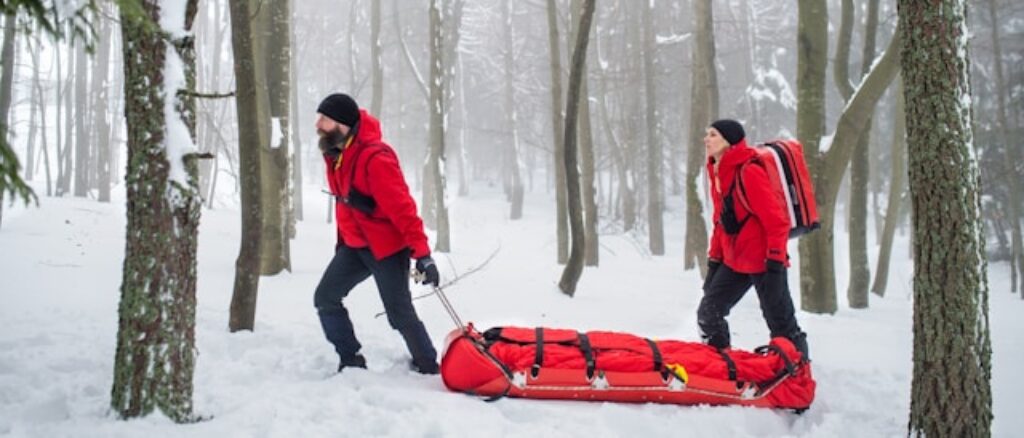
Skiing is a physically demanding sport that involves navigating challenging terrain, unpredictable weather conditions, and high speeds. While skiing is generally safe when done correctly, accidents and injuries can happen, especially if skiers aren’t properly prepared or aware of the risks. Understanding how to prevent common injuries and knowing basic first aid are essential to staying safe on the slopes. This section covers strategies for injury prevention, common skiing injuries, how to handle minor and serious injuries, and rehabilitation after an injury.
1. Common Skiing Injuries
While skiing can be a relatively safe activity when proper precautions are taken, certain injuries are more common due to the physical demands of the sport. Some injuries are mild and can be treated with basic first aid, while others may require professional medical attention.
Knee Injuries
Knee injuries are among the most common injuries in skiing. The twisting motions involved in turning and stopping can put significant stress on the knees, particularly on the ligaments.- ACL (Anterior Cruciate Ligament) Tears: This occurs when the ACL, one of the major stabilizing ligaments in the knee, is overstretched or torn. ACL injuries often occur during sudden changes in direction or from falls.
- MCL (Medial Collateral Ligament) Tears: The MCL is another key ligament in the knee, often injured when the skier’s knee collapses inward, such as during a fall or collision.
Wrist and Thumb Injuries
Falls are common in skiing, and when skiers extend their arms to brace for impact, they risk injuring their wrists and thumbs. The most frequent injury is the “skier’s thumb,” which involves tearing or straining the ulnar collateral ligament in the thumb.- Wrist Fractures: Falling on an outstretched hand can lead to fractures in the wrist bones.
- Sprained Thumbs: Holding onto ski poles tightly during a fall can cause the thumb to bend backward, leading to ligament injuries.
Shoulder Injuries
The shoulders are also vulnerable to injury from falls, especially when skiers land awkwardly on their arms. Common shoulder injuries include:- Dislocations: A shoulder dislocation happens when the upper arm bone pops out of the shoulder socket due to impact.
- Rotator Cuff Tears: The rotator cuff muscles and tendons can tear when a skier falls on an outstretched arm or tries to catch themselves during a fall.
Head Injuries
Head injuries can occur in collisions or from falls, particularly when skiers lose control at high speeds. Wearing a helmet reduces the risk of serious head injuries, but concussions are still possible.- Concussions: A concussion is a traumatic brain injury caused by a blow to the head. Symptoms include dizziness, headaches, confusion, and loss of consciousness in severe cases.
Fractures
Fractures are another common injury in skiing, typically involving the arms, legs, or collarbone. These can occur from falls, collisions, or when skis get caught in the snow.
2. Preventing Injuries
While not all injuries can be prevented, taking certain precautions can significantly reduce your risk. Injury prevention begins with proper preparation, using the right gear, maintaining fitness, and skiing within your limits.
Use Properly Fitted Gear
Ensuring that your ski equipment is properly fitted and in good condition is one of the most effective ways to prevent injuries.- Ski Boots: Boots should fit snugly but not too tight. Loose boots can cause a lack of control, leading to falls and potential injuries.
- Bindings: Have your bindings adjusted to the correct DIN setting based on your height, weight, and skill level. Bindings that are too tight may not release during a fall, increasing the risk of injury.
- Poles: Use poles of the correct length to ensure proper posture and balance on the slopes.
- Helmet: Always wear a helmet to reduce the risk of head injuries. Make sure it fits securely and comfortably.
Warm-Up Before Skiing
Skiing places significant stress on your muscles and joints, so warming up before hitting the slopes can help reduce the risk of strains and sprains. A good warm-up routine includes dynamic stretches and light aerobic activity to increase blood flow to your muscles.- Dynamic Stretches: Focus on stretching your quads, hamstrings, calves, hips, and back.
- Light Aerobic Activity: A few minutes of jogging in place, jumping jacks, or brisk walking can get your heart rate up and prepare your body for the physical demands of skiing.
Maintain Proper Form and Technique
Using correct skiing techniques can reduce the likelihood of falls and injuries.- Stay Centered Over Your Skis: Keep your body weight evenly distributed over both skis to maintain balance.
- Bend Your Knees: A slight bend in the knees allows you to absorb bumps and adjust to changes in terrain.
- Avoid Leaning Back: Leaning back shifts your weight onto the tails of your skis, which can cause you to lose control. Instead, keep your weight forward, over the balls of your feet.
Build Core and Leg Strength
Skiing requires strong legs, hips, and core muscles. Strengthening these areas can help you maintain stability and control on the slopes, reducing the risk of injury.- Leg Exercises: Squats, lunges, and leg presses are great for building lower body strength.
- Core Exercises: Planks, Russian twists, and mountain climbers can strengthen your core muscles, improving your balance and posture while skiing.
Ski Within Your Limits
Don’t attempt to ski on trails that are too advanced for your skill level. Stick to runs that match your ability, and avoid pushing yourself too hard, especially when you’re tired. Fatigue can increase the risk of falls and injuries.Take Breaks and Stay Hydrated
Skiing is physically demanding, and fatigue can lead to poor decision-making and lack of control. Take regular breaks to rest, refuel, and rehydrate. Dehydration can impair your physical and mental performance, increasing your risk of accidents.
3. Immediate Injury Response: First Aid for Skiing Injuries
Despite taking preventive measures, accidents and injuries can still happen. Knowing how to administer basic first aid can make a big difference, especially in the moments immediately following an injury.
R.I.C.E. Method for Minor Injuries
For minor injuries like sprains, strains, and bruises, the R.I.C.E. method is an effective way to reduce pain and swelling:- Rest: Stop skiing immediately and rest the injured area to avoid further damage.
- Ice: Apply ice to the injured area to reduce swelling. Use a cold pack or snow wrapped in cloth, and apply it for 15–20 minutes at a time.
- Compression: Wrap the injured area with a bandage or cloth to help reduce swelling and provide support.
- Elevation: Elevate the injured limb above heart level if possible, to reduce swelling.
Treating Cuts and Scrapes
For minor cuts or scrapes, clean the wound with antiseptic wipes or clean water. Apply a sterile bandage or adhesive dressing to protect the wound. If the cut is deep or bleeding heavily, seek medical attention immediately.What to Do in the Event of a Fall
If you fall while skiing, take a moment to assess any potential injuries before getting up. If you experience pain, swelling, or difficulty moving a limb, stay where you are and signal for help. If you’re able to get up, move off the trail and out of the way of other skiers before checking yourself for injuries.Dealing with Head Injuries
If someone suffers a head injury (especially if they lose consciousness), it’s important to take the situation seriously. Even if the person feels fine, they could have a concussion or other internal injuries.- Signs of a Concussion: Look for symptoms such as dizziness, confusion, nausea, headache, sensitivity to light, and loss of coordination. If any of these symptoms are present, the skier should stop skiing immediately and seek medical attention.
- When to Call for Help: If the injured skier loses consciousness or shows signs of severe head trauma, call ski patrol immediately and do not attempt to move them.
4. Responding to Serious Injuries
In the case of more serious injuries, such as fractures or dislocations, immediate action is required to prevent further harm. Knowing how to respond in these situations can make a significant difference in the injured person’s outcome.
Fractures
If you suspect that someone has fractured a bone:- Do Not Move the Injured Area: Moving the injured limb can cause further damage. Keep the injured limb immobilized and as still as possible.
- Call Ski Patrol: In the event of a serious fracture, signal for ski patrol or call for emergency assistance. Most ski resorts have a dedicated team trained in handling serious injuries.
- Apply Ice: If available, apply ice to the injured area to reduce swelling.
- Keep the Person Warm: While waiting for ski patrol, help the injured person stay warm by using jackets, blankets, or other clothing to prevent hypothermia.
Dislocations
Dislocations often occur in the shoulders or knees and can be extremely painful.- Immobilize the Joint: Do not attempt to pop the joint back into place. Immobilize the joint in the position it is in and wait for professional medical help.
- Call Ski Patrol: Like fractures, dislocations require immediate assistance from trained medical professionals.
Back or Neck Injuries
Spinal injuries are rare but serious and can occur in high-speed falls or collisions.- Do Not Move the Injured Person: If someone has suffered a back or neck injury, avoid moving them, as this could worsen the injury.
- Call for Help: Immediately call ski patrol or emergency services. Keep the person as still and comfortable as possible until help arrives.
5. Rehabilitation After a Ski Injury
Recovering from a skiing injury can be a long process, depending on the severity of the injury. Taking the time to properly rehabilitate is crucial to ensuring a full recovery and avoiding re-injury.
Follow Medical Advice
After any significant injury, it’s important to follow the advice of your doctor or physical therapist. Don’t rush the recovery process or return to skiing too soon, as this can lead to re-injury or prolong your recovery.Physical Therapy
For injuries such as ACL tears, fractures, or dislocations, physical therapy is often necessary to rebuild strength and regain mobility. Your therapist will guide you through exercises that help strengthen the injured area and restore your range of motion.Strengthening Exercises
Once your doctor clears you to resume activity, focus on strengthening the muscles that support the injured area. For example:- After a knee injury, work on strengthening your quadriceps, hamstrings, and calf muscles.
- After a shoulder injury, focus on rebuilding the rotator cuff and shoulder muscles.
Return to Skiing Gradually
When you’re ready to return to skiing, start slowly. Stick to easy runs and avoid high-speed or advanced terrain until you feel confident and pain-free. Wearing a brace or supportive gear (like a knee brace) may help prevent re-injury.
Post-Skiing Care and Recreation
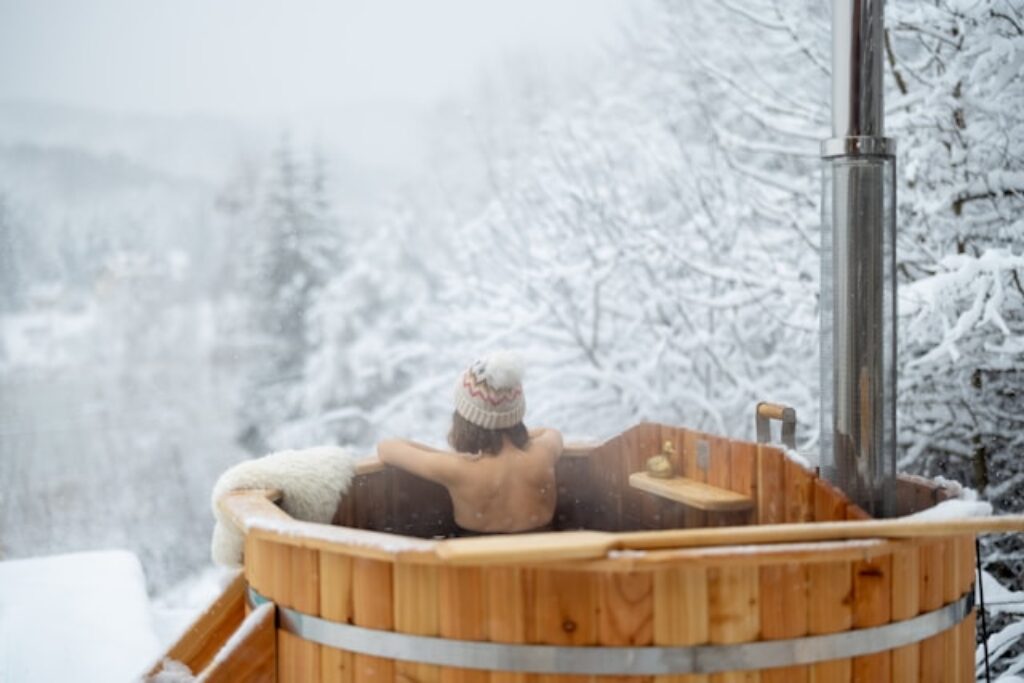
After a day of skiing, it’s important to take time for proper post-skiing care to help your body recover and rejuvenate. Skiing is physically demanding, involving the use of muscles you may not typically engage in everyday activities. Without proper recovery, you can experience soreness, fatigue, and even increase your risk of injury. In addition to physical recovery, skiing is also about enjoying the après-ski (after-ski) culture, which offers an opportunity to unwind and relax with fellow skiers. In this section, we’ll cover essential post-skiing care practices—such as stretching, hydration, and nutrition—as well as the recreational aspects of the après-ski experience, including spa treatments and social activities.
1. Stretching and Cool-Down
Stretching after skiing is crucial to alleviate muscle stiffness, promote flexibility, and reduce the risk of injury. Cooling down properly allows your heart rate to gradually return to normal and helps flush out lactic acid that builds up during intense physical activity.
Why Stretching Is Important
After skiing, your muscles are often tight and fatigued from the intense physical exertion required to maintain balance, navigate turns, and absorb the impact of skiing over varied terrain. Stretching not only helps release tension in the muscles but also promotes blood flow, speeding up recovery.Key Post-Skiing Stretches
Focus on stretching the muscles that were most engaged during skiing, including the legs, hips, and lower back.- Quadriceps Stretch: Stand on one leg, grab the ankle of the opposite leg, and pull it toward your glutes. This stretches the front of your thigh. Hold for 20–30 seconds, then switch legs.
- Hamstring Stretch: Sit on the floor with one leg extended. Reach forward and try to touch your toes, keeping your back straight. This targets the back of the thigh. Hold for 20–30 seconds, then switch legs.
- Calf Stretch: Stand facing a wall, place one foot behind the other, and lean forward while keeping your back heel on the ground. This stretch helps release tension in the calves.
- Hip Flexor Stretch: Kneel on one knee with the other leg in front, forming a 90-degree angle. Push your hips forward to feel a stretch in the front of the hip. Hold for 20–30 seconds, then switch legs.
- Lower Back Stretch: Lie on your back, bring one knee to your chest, and hold it while keeping the other leg extended. This stretches your lower back muscles and helps relieve tension in that area.
Foam Rolling
In addition to stretching, using a foam roller is a great way to perform self-myofascial release, which can help reduce muscle tightness and improve flexibility. Focus on rolling out your quadriceps, hamstrings, calves, and IT band (side of the thigh). Roll slowly over each muscle group and pause on any particularly tight spots.
2. Hydration and Nutrition
Skiing can be a physically exhausting activity, especially at high altitudes, where dehydration can occur more quickly due to dry air and increased exertion. Proper hydration and nutrition after skiing are essential to replenish lost fluids, restore energy, and support muscle recovery.
Hydration
Drinking water before, during, and after skiing is vital to prevent dehydration. Skiing at higher altitudes can cause your body to lose more fluids through breathing and perspiration, even in cold weather. Aim to drink at least 16–24 ounces of water within an hour of finishing your ski session. If you’ve been skiing intensely or for several hours, you might also consider electrolyte drinks to replace lost salts and minerals.Post-Skiing Nutrition
After a day of skiing, your body needs proper fuel to repair muscles and replenish energy stores. Focus on a balanced meal that includes:- Protein: Helps repair and rebuild muscles that were worked during skiing. Lean meats, fish, eggs, and plant-based proteins (such as beans and tofu) are excellent sources.
- Carbohydrates: Replenish glycogen (energy) stores that were depleted during skiing. Complex carbohydrates such as whole grains, sweet potatoes, and brown rice are ideal.
- Healthy Fats: Support muscle recovery and provide sustained energy. Avocados, nuts, seeds, and fatty fish (like salmon) are good sources of healthy fats.
- Vitamins and Minerals: Fresh fruits and vegetables are rich in antioxidants, which help combat inflammation and support overall recovery. Incorporate leafy greens, berries, and colorful vegetables into your post-ski meal.
Sample Post-Skiing Meal:
A grilled chicken or salmon salad with mixed greens, quinoa, and avocado, drizzled with olive oil, paired with a side of roasted sweet potatoes and a glass of water or an electrolyte drink.Snacks for Quick Recovery:
If you’re not ready for a full meal right after skiing, opt for high-protein, energy-boosting snacks like:- Greek yogurt with nuts and honey
- Protein bars
- A banana with peanut butter
- Trail mix with dried fruit and seeds
3. Spa and Recovery Treatments
Ski resorts often offer access to spa services, hot tubs, and saunas, which are excellent for relaxing sore muscles and promoting recovery after a day on the slopes. These treatments not only help alleviate muscle tension but also improve circulation, allowing your body to recover more efficiently.
Hot Tubs and Jacuzzis
Soaking in a hot tub or Jacuzzi after skiing can be incredibly soothing for tired muscles. The heat increases blood flow, which helps reduce muscle soreness and stiffness. The warm water also helps loosen up tight joints and promote relaxation. Just be sure to hydrate well before and after using a hot tub, as prolonged exposure to heat can lead to dehydration.Saunas
A sauna is another popular post-skiing recovery option. The dry heat in a sauna helps improve circulation, remove toxins through sweat, and relax tense muscles. Spending 10–15 minutes in a sauna can also ease mental stress and promote a sense of calm. As with hot tubs, it’s important to stay hydrated when using a sauna.Massage Therapy
If you’re feeling particularly sore or stiff after skiing, a massage can do wonders for your recovery. Many ski resorts offer sports massage or deep tissue massage, which focus on relieving muscle tension, reducing inflammation, and increasing flexibility. Massage therapy can also help improve circulation, reduce the risk of injury, and enhance overall relaxation.Cryotherapy
Some ski resorts offer cryotherapy, a treatment that exposes your body to extremely cold temperatures for a short period. This technique can reduce muscle soreness and inflammation, making it a popular recovery method for athletes. While not as common as hot tubs or massages, cryotherapy is gaining popularity in sports recovery for its quick and effective results.Stretching Classes and Yoga
Many resorts also offer post-skiing stretching classes or yoga sessions designed to target muscles used during skiing. These classes focus on improving flexibility, balance, and relaxation. Yoga can help align your posture, reduce tension in the muscles, and promote mental relaxation, making it an ideal recovery activity.
4. Mental Relaxation and Recovery
Skiing is not only physically demanding but can also be mentally tiring, especially if you’ve been concentrating on navigating challenging terrain. Taking time to relax your mind is just as important as caring for your body.
Mindfulness and Meditation
Practicing mindfulness or meditation after skiing can help clear your mind, reduce stress, and improve overall well-being. Mindfulness encourages you to focus on the present moment, which can help alleviate any mental fatigue or anxiety you may have experienced on the slopes. A short meditation session, even just 5–10 minutes, can help you feel more centered and relaxed.Unwinding with Friends and Family
Part of the joy of skiing is the social aspect of the sport, and many skiers look forward to the après-ski experience. Whether it’s relaxing in a cozy lodge by the fire, sharing stories of the day’s adventures, or enjoying a meal with fellow skiers, après-ski is all about unwinding and connecting with others.
5. Après-Ski Culture and Social Activities
Après-ski (French for “after skiing”) is a key part of the skiing experience, blending socializing, relaxation, and enjoyment after a long day on the slopes. Ski towns and resorts around the world are known for their après-ski culture, which offers a variety of activities that range from casual to lively, depending on the atmosphere you’re seeking.
Après-Ski in the Lodge
Many skiers head straight to the lodge after skiing to warm up by the fire with a hot drink or a light snack. Popular post-skiing beverages include hot chocolate, mulled wine, cider, or a local craft beer. The lodge atmosphere is typically cozy and relaxed, offering a great place to unwind and share stories with friends or meet fellow skiers.Après-Ski Dining
After a day of skiing, many people enjoy indulging in hearty meals that replenish energy and celebrate local cuisine. Ski towns are known for their vibrant dining scenes, offering everything from gourmet dinners to casual pub fare.- Fondue and Raclette: In Alpine regions, après-ski often includes indulgent meals of melted cheese, such as fondue or raclette, served with bread, potatoes, and charcuterie.
- Barbecue and Grilled Meats: Many ski lodges and restaurants offer hearty meals like steaks, burgers, or barbecue to help refuel after skiing.
Live Music and Entertainment
In more lively après-ski settings, ski resorts often feature live music, DJ sets, or even outdoor parties. Many skiers enjoy dancing and socializing, especially at European ski resorts where après-ski parties are a tradition. If you’re looking for a more energetic way to wrap up your day, check out bars or outdoor venues that offer entertainment.Winter Activities Beyond Skiing
Après-ski isn’t just about eating and socializing; there are plenty of other fun winter activities to explore:- Ice Skating: Some ski resorts offer ice skating rinks where you can enjoy a relaxed evening gliding across the ice.
- Sledding and Tobogganing: If you’re looking for an adrenaline rush without skiing, many resorts offer sledding or tobogganing, providing a fun way to enjoy the snow with family and friends.
- Snowshoeing: If you’re up for a more peaceful and scenic activity, snowshoeing allows you to explore snow-covered trails at your own pace, offering a quiet connection with nature.
Conclusion
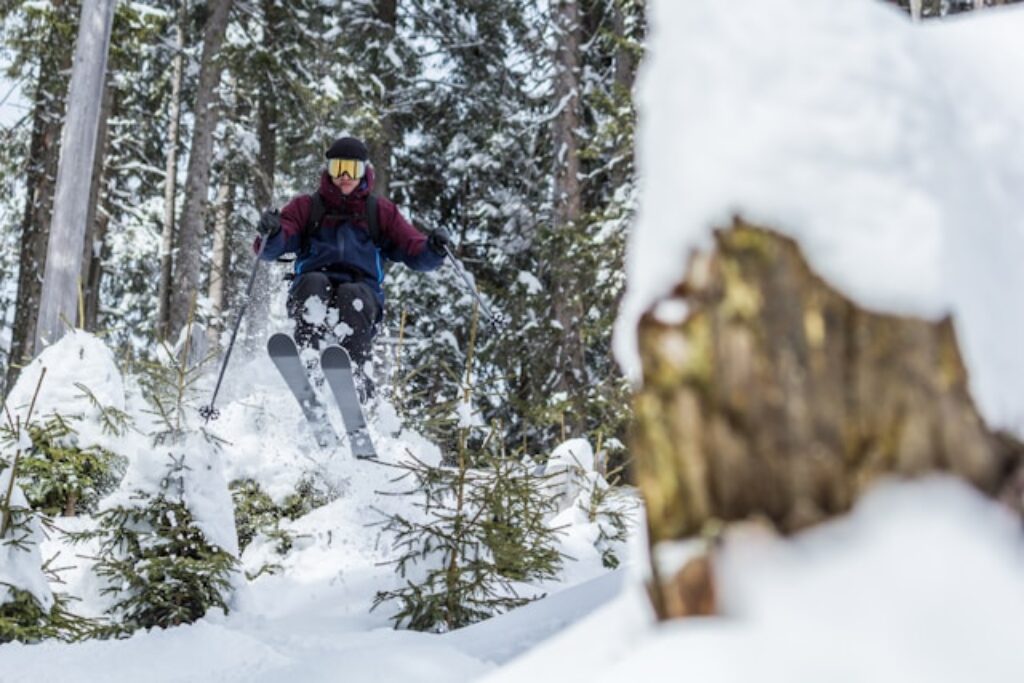
Skiing is a thrilling and multifaceted sport that offers something for everyone, whether you’re a beginner taking your first steps on the slopes or an experienced skier exploring advanced techniques and challenging terrains. From choosing the right type of skiing that suits your style, to selecting proper gear that enhances both safety and performance, skiing is a sport that requires thoughtful preparation and ongoing learning. By mastering basic techniques and progressing to more advanced skills, you can confidently navigate a variety of terrains while minimizing the risks associated with skiing.
Safety is paramount in skiing, and understanding how to prevent injuries, respond to emergencies, and handle the challenges of mountain weather ensures that you can enjoy the sport responsibly. With the right precautions, such as wearing a helmet, following trail etiquette, and respecting avalanche safety in the backcountry, you can significantly reduce the risk of accidents and focus on the joy of skiing.
Beyond the physical aspects, skiing offers a holistic experience that encompasses both mind and body. Proper post-skiing care—stretching, hydration, nutrition, and spa treatments—ensures that you recover effectively and maintain your performance for future days on the slopes. And of course, the après-ski culture is a vital part of the skiing experience, offering opportunities to unwind, socialize, and embrace the unique charm of ski resorts.
Whether you’re drawn to the rush of downhill skiing, the peacefulness of cross-country trails, or the creativity of freestyle skiing, the sport offers endless possibilities for adventure, fitness, and enjoyment. By staying prepared, practicing safety, and embracing the broader skiing lifestyle, you can make the most of your time on the mountain and create lasting memories with friends, family, and fellow skiers.



